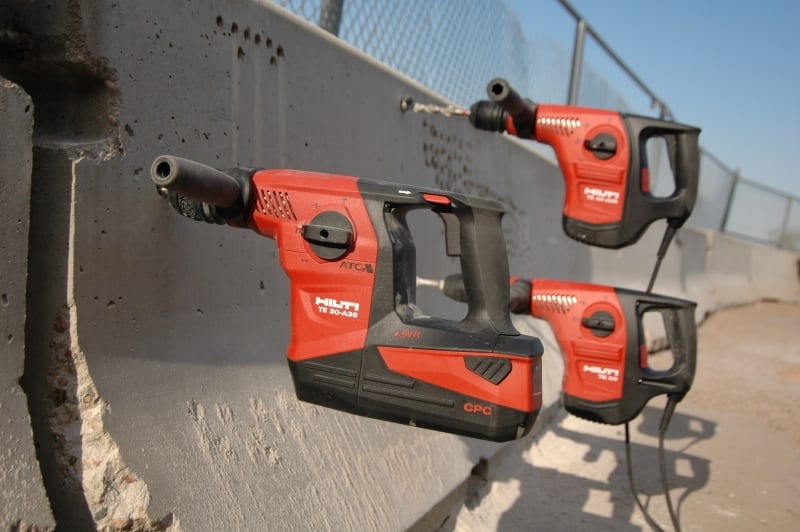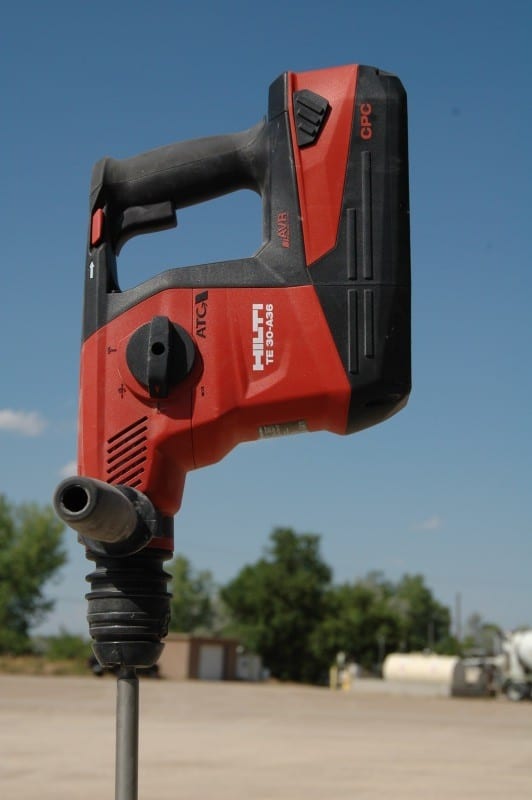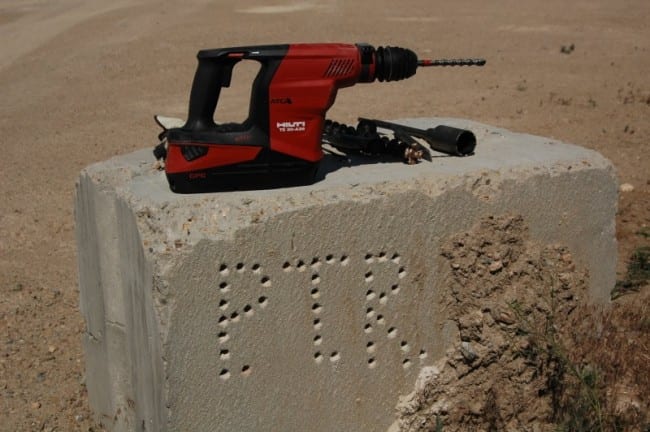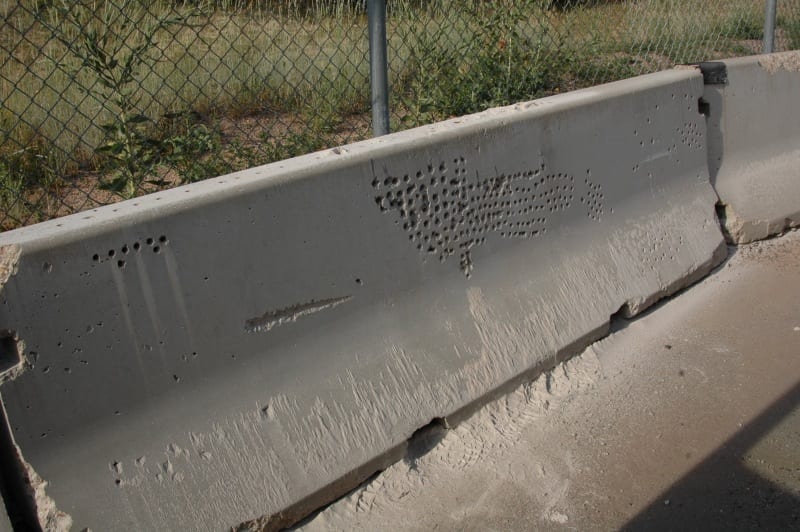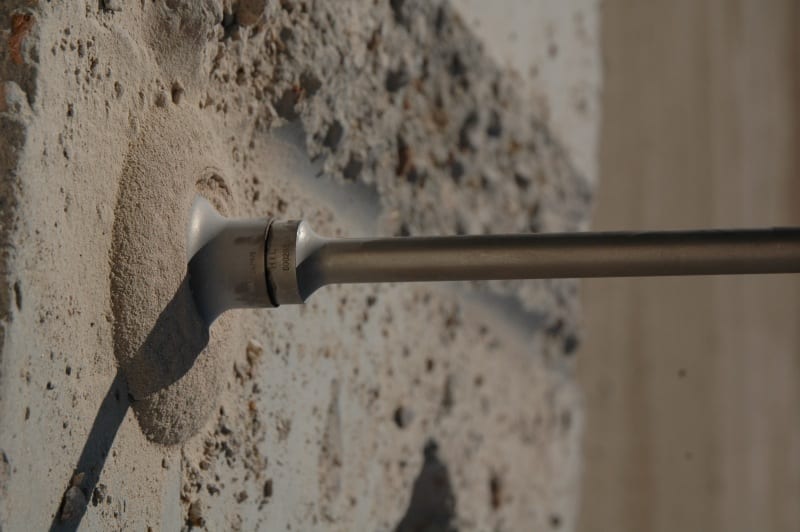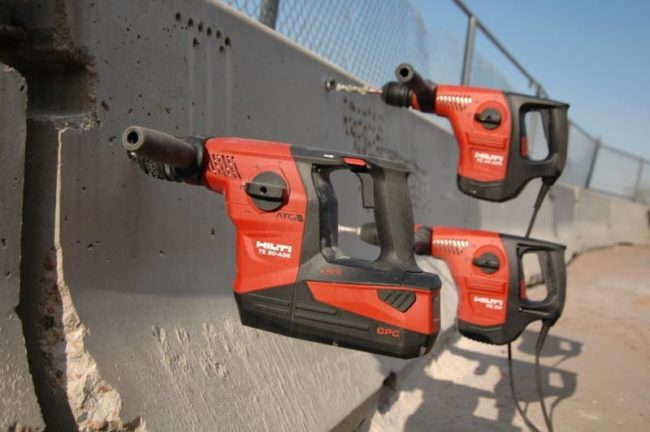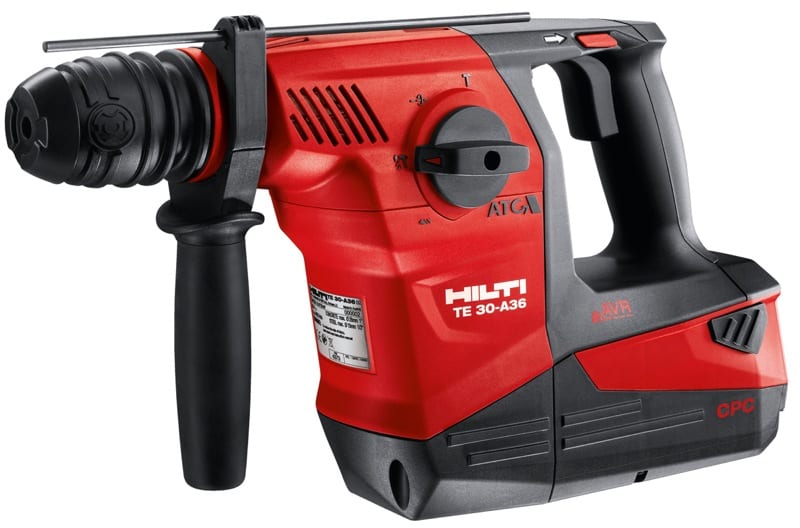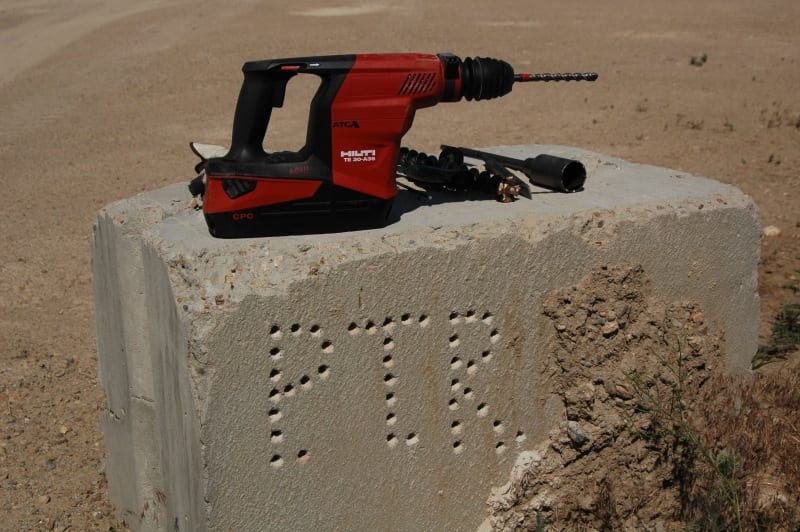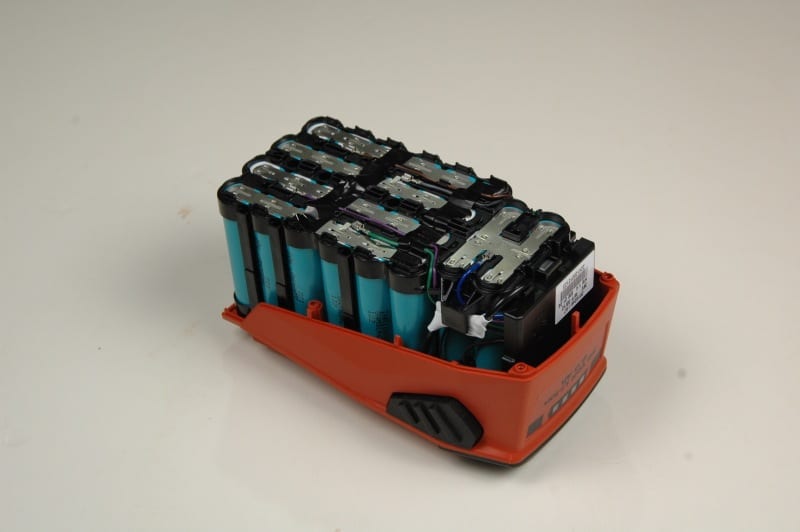I first saw the Hilti TE 30-A36 cordless rotary hammer a few years ago in a training lab at the company’s global headquarters in Liechtenstein. Back then, I got to run an early version of the tool to drill through concrete test slabs, and I was intrigued by the manufacturer’s goal of making the fastest-drilling SDS Plus rotary hammer ever. I’ve always found how a rotary hammer works fascinating, and I was duly impressed with the brand’s energy-dense 6.0 amp-hour (Ah) battery pack—the highest amp-hour battery I have seen to-date. Hilti was one of the first to use 2.0 Ah cells in their battery pack fabrication, and it is indicative of the premium touches found throughout the construction of this tool.
Out of the Box
The Hilti TE 30-A36 cordless rotary hammer is a noticeably large rotary hammer for a cordless model. It’s nothing as large as the Hilti TE 1000-AVR breaker, but it’s a size bigger and 1.4 pounds heavier than its predecessor, the 36-volt Hilti TE 7-A, which probably makes it the largest cordless rotary hammer on the market.
In fact, it’s powerful enough for Hilti to classify it as the world’s first cordless combihammer. According to the brand, a combihammer, or combination hammer, is a term used in the industry to denote a rotary hammer strong enough to: A) Easily handle 3/4-inch bits, and B) Perform “meaningful” chipping tasks on the job.
Like other cordless models, the TE 30-A36 fits SDS Plus bits, which are the smallest shank size bits used in rotary hammers. But, unlike most other cordless models, this tool was designed to beat the pants off of any other SDS Plus hammer, cordless or corded. I put that assertion to the test and was impressed with what I found—but more on that later.
Hilti TE 30-A36 Cordless Rotary Hammer Features
The tool, charger and two batteries come in a sturdy plastic case, along with a side handle, depth-stop rod and a tube of bit grease. The case comes complete with those infamous upside-down latches European tool brands like Hilti are known for. So, to keep from dumping the contents out unintentionally, you must check the direction of the model number written on the latch before opening, or borrow my trick of posting stickers labeled “Top” or “Bottom!” conspicuously on both sides. The case is extra large (22”W x 18-1/4”H x 6-1/4”D). This may make it hard to fit in the truck box, but it gives plenty of room to hold a good variety of bits up to 21 inches long.
The Hilti TE 30-A36 cordless rotary hammer works in three different modes: Rotation only, hammer only and rotation with hammering for standard drilling, chipping, and rotary hammer drilling, respectively. A fourth stop on the mode selection dial lets you rotate a chisel bit to any of 12 different positions to help dial in the most effective chipping posture with the tool.
On the handle, above the variable speed trigger, is a sliding button for switching between clockwise and counterclockwise rotation. A middle position locks the tool. I rely on this safety position whenever I change bits or carry the tool around as it’s very easy to pull the trigger inadvertently whenever you grip the rear handle.
The tool’s large two-finger trigger and rubberized surfaces on the side and rear handles make for a comfortable feel, even with bulky anti-vibration or winter gloves on.
High Tech Features
On the inside, the biggest advancement in the Hilti TE 30-A36 cordless rotary hammer is its brushless motor. Building this tool around a computer-controlled powerplant makes the tool more efficient than it would be with a commonly-used permanent magnet DC motor. The motor loses less energy to heat and friction, which increases the run time, and the sealed motor design and lack of brushes means less maintenance and longer life. It is also a premium-priced technology that adds a few ft-lbs to the tool’s sticker shock.
The massive 6.0 Ah battery pack consists of thirty 2.0 Ah cells and weighs almost four pounds. This big high-octane fuel tank is an important part of the equation for getting corded tool performance out of a cordless tool—and getting it for long enough to make it worthwhile on the job site. Four LEDs on the battery packs indicate the level of charge when one of the battery latch buttons is pressed. The lights also signal alarms. One LED blinking means the battery is dead or overheated, and all four LEDs blinking indicates that the tool motor is overloaded or overheated.
Hilti also instituted a few of their existing technologies into this premium cordless tool such as their Active Torque Control (ATC) and Active Vibration Reduction (AVR) systems. The former employs an inertial sensor that cuts power to the tool if the bit binds and the tool body begins to spin. The latter mechanically decouples the vibration-causing mechanism of the tool from the rear handle via a flexible metal plate that connects the two via isolating spring mounts.
In Use
My first test of the Hilti TE 30-A36 cordless rotary hammer was drilling holes in my basement slab for installing a radon fan system. Drilling modest-size test holes in the mild concrete was so effortless, the only insight I received was that this tool was really fast in this ho-hum application. The radon mitigation contractor I was working with also mentioned that the Hilti drilled very quickly and that his basis of comparison was a much larger corded SDS Max tool.
For more of a challenge, I headed out to the local ready-mix plant and set upon a three-year-old leftover barrier wall. The 2,500-3,000 PSI concrete yielded easily to standard drilling and core drilling bits, and I felt like Michelangelo carving the softest marble while in chipping mode. Until I was told the mix strength of the 1-ton block, I had assumed it was very weak concrete.
Besides the obvious speed advantages of the TE 30-A36, over time I also came to appreciate its substantial mass and vibration reduction features. Both worked in concert to make the user experience fairly tame for the amount of work I was getting done. A heavier tool has more inertia and therefore jerks the user around less than a lighter tool. Similarly, the smaller and lighter tools I have used usually have a buzzing or rattling feeling that gives the sensation of transmitting the sharp vibrations more directly into my joints.
The Hilti TE 30-A36 cordless combihammer has smooth ergonomics also proved helpful. During extended periods of drilling into concrete, you’ll find yourself leaning on the tool with any available body part to take some of the strain off your wrists and elbows, so a tool with a lot of broad surfaces and rounded edges like the TE 30-A36 is more comfortable to use. For pushing with your legs, the grippy rubber surface of the slightly springy side handle helps it grip a dusty pant leg well, and the flat back of the battery makes a comfortable platform to lean against.
I never bound a bit suddenly enough to enact the inertial sensor switch, but I did get the mechanical clutch to kick in at times while using core bits. The clutch seemed to be set at a good level—not weak enough to affect productivity and not strong enough to deliver a jarring blow to the user. Its smooth, intermittent action gave me ample notice that it was time to clear the dust out of the hole before I could proceed.
Hilti TE 30-A36 Cordless Rotary Hammer Speed and Power Testing
I loved how the tool worked on its own, but to compare the Hilti TE 30-A36 cordless rotary hammer to other top tools I have admired through the years I had to visit my traditional testing grounds for rotary hammers. Years ago I discovered retired highway barriers at a highway department facility, and I am graciously allowed to use them for my occasional concrete testing needs. These barriers are ideal for controlled quantitative testing since they were made to exacting government specs with 3,000 PSI concrete and aggregate up to 1-1/2 inches, and they have been fully cured for decades. Their size and shape allow me both vertical and horizontal drilling, and I can easily find rebar within them to jam bits against when testing clutch action.
To follow up on Hilti’s claims that their cordless TE 30-A36 combihammer could out-drill any other SDS Plus rotary hammer (or combihammer), I raced it against the brand’s largest corded SDS Plus hammer, the 12.9–pound TE 40. Trading the same 3/4-inch bit back and forth, I drilled holes 5-7/8 inches deep and timed the individual trials.
The result? True to the claims, the cordless tool was 16% faster than the larger corded tool with average times of 24.26 seconds and 28.15 seconds, respectively.
Beating Itself Up
Then, to test Hilti’s claim that the TE 30-A36 could even outrun corded tools of similar stature in the next bit size class up, I ran it against the brand’s 12.9-pound SDS Max tool, the TE 50. To its advantage, the 3/4-inch SDS Max bit had 1-1/2 times the mass of the SDS Plus bit of similar length, but the cordless tool still prevailed by 6% over the TE 50’s average time of 25.73 seconds.
To see how some standout tools from the not-too-distant past performed in comparison, I took along the winners of some previous tests I was part of. I was surprised at how outclassed these tools were in comparison to the Hilti.
The previous fastest 36-volt rotary hammer in my experience took 136% longer than the Hilti with a time of 55.81 seconds. And my former fastest 1-inch class corded rotary hammer was even slower, taking 186% longer than the Hilti, with a time of 69.38 seconds. Admittedly, 3/4-inch bits are out of these older tools’ optimum range, but in trials drilling 1/2-inch holes 3-7/8 inches deep, the Hilti stilled trounced them both with an average speed of 7 seconds versus the corded tools’ 11 seconds and the 36-volt tools’ 13 seconds.
Hilti TE 30-A36 Cordless Rotary Hammer Performance
During the comparative trials, I noticed that the TE 30-A36 spun a lot faster and spit out concrete dust more vigorously than the larger corded Hilti tools. According to Hilti, this new tool has a “higher mass hammering mechanism”. Higher than what is not known, but it does seem like the engineers found a real sweet spot between motor RPM, impact energy and impact timing that makes it drill very effectively, even through hard aggregate. Whenever rocks in my highway barrier stalled out the smaller tools I brought along, I had to bang the bits in and vary the feed pressure to get that good lucky hit needed to start the bit into the rock. But with the TE 30-A36, my progress would simply slow momentarily, and then a burst of colored rock dust would emerge as evidence of the tool’s superior pulverizing prowess.
Similarly, when I switched from the 3/4-inch bit to the 1/2-inch bit, I had the sensation that the tool was just melting into the concrete—it was that effortless.
Hilti TE 30-A36 Cordless Rotary Hammer Specifications
- Model: TE 30-A36
- Bit Type: SDS Plus (Hilti TE-C)
- Bit Size (solid/core): 1/4 in. to 1-1/8 in./up to 3-1/2 in.
- Max. RPM: 853
- Max. Impacts per Minute: 4,500
- Impact Energy: 2.7 ft-lbs.
- Weight: 12.2 lbs.
- Price: $1,599
Run-Time
To determine the drilling run-time of a single battery, I drilled 1/2-inch by 3-7/8-inch holes, ten at a time, with short rests in between sets. The tool and battery remained hot the entire time, however—the rests were just for a minute or two. The TE 30-A36 managed 103 holes before petering out. For historical context, that’s about three times the longevity of a previous 36-volt run-time winner.
During heavy chipping uses, I could get about 30 minutes of work out of a battery—and that was when running the tool nearly continuously in very hot conditions. I was impressed with the run-time, and I found that the amount of work contained in the two batteries was enough to wear out my drilling arm for the day. When I was up for some more, charging a battery at room temperature took about 45 minutes. I would expect longer charge times if a fully-heated battery was popped into the charger without a cool down period.
Concrete Drilling Best Practices
Drilling and chipping concrete is hard work—noisy, dusty, and filled with joint-jarring vibration. So here are some tester-proven tips to make your time “on the beat” go as smoothly and quickly as possible.
- Personal Protective Equipment (PPE)
Personal protective equipment is a must. The unpleasant spray of shrapnel to the face at the start of each hole makes eye protection a given, but don’t neglect the rest of your body. Effective hearing protection is a necessity as well. The sharp impulse noises will damage your hearing even if they don’t hurt your ears. The increase in efficient job site vacs over the past decade has been driven by European countries classifying the silica dust within concrete as a public health hazard and subsequent legislation forcing its control. In some countries, drilling into a bridge, roadway, or downtown building necessitates capturing the hazardous dust. If incidental exposure to the public at large is considered toxic, it follows that a worker at its source would be wise to avoid unnecessary exposure by wearing a dust mask when drilling, chipping or sawing concrete, and even when sweeping up concrete dust. - Vibration Protection
The chink in the armor for most of us when drilling concrete is the lack of protection from vibration. Europe and England have stringent rules in place to limit a worker’s exposure to vibration, but such concerns have yet to cross the pond in an official way. Wearing anti-vibration gloves is the first line of defense against hand-arm vibration syndrome (HAVS) and other debilitating conditions, but holding tools with a looser grip and switching up tasks to avoid overexposure to concentrated vibration can help too. - You Determine the Drilling Speed
“Letting the tool do the work” is a myth with rotary hammers. In all the testing I’ve done, the harder you push, the faster the tool drills—within reason, that is. I’ve performed extreme-force testing where using more than 200 pounds of force made most small corded tools drill notably faster than with 100 pounds of force, but it overwhelmed and slowed a few of the models. So without taking the load on the tool (or your own wrists) to extremes, feel free to lean into it to get the work done. Don’t hesitate to push on the tool with hips, legs or chest to take the strain off your wrists. Bracing your arms along the top of your bent legs is a good strategy to apply more force against a vertical surface down low for controlled drilling with the aid of your leg muscles. And holding your extended arms tight in between your legs and squatting is a good way to apply solid force to holes in the floor without leaning over and straining your back. Similarly, you can even sit on the back of the tool with one leg sometimes to easily add force straight down. - Push with Your Body
Just try anything to help employ more of your balanced mass instead of just pushing with just your arms. Smart ergonomics will help you reduce the strain on your joints while drilling faster all day long. - Clear That Dust!
When drilling into horizontal surfaces, dust building up in the hole is the biggest hindrance to progress. You may need to vacuum or blow out the hole before fitting an anchor in, but you don’t need to slow down that long to clear the dust while drilling. Just pull the bit in and out of the hole firmly and quickly while it’s spinning at full speed. The outward motion helps a little, but it is really the piston action of the forward action that clears the most dust. - Listen to Your Tool
When your tool stops moving forward, listen to determine the holdup. Rebar rings out with a clattering sound discernible even through the best hearing protection. If the bit spins in place without the metallic clatter, you are just centered on a tough piece of aggregate. Pull the tool out while spinning to clear the dust and jam it back in the hole forcefully a few times. Good shocking blows like this are often enough to make the bit bite into the solid rock. - Use Application-specific Drilling Techniques
When drilling anchor holes through delicate surfaces like bricks or mortar, you run the risk of making an oversize hole or even cracking the materials. To minimize the risk, run the rotary hammer in drill-only mode to make a scraping cut without the hammering action. It takes longer but provides finer control in more fragile materials. Another good idea is to switch to a hammer drill for this operation; it is often a better tool for drilling soft and brittle materials. - Mark Your Hole
To start holes in an exact spot, use a hammer and chisel as a center punch to make a divot for the bit to center itself in. A less accurate but quicker alternative is to push really hard on the tip of your rotary hammer bit while pulling the trigger very gently until you make a divot. - Stitch-Drill Larger Diameter Holes
For making very large holes without a large diamond bit coring rig, your best option is to stitch-drill the hole with a series of small holes drilled around the perimeter. To get the holes close together, it’s best to center punch a series of divots first. To connect the drilled holes, go around the circle with a larger bit using every hole, or every other hole as a pilot hole (depending on how closely spaced the pilot holes are). Remember to use your larger bit size to more accurately determine the diameter of your stitched hole.

